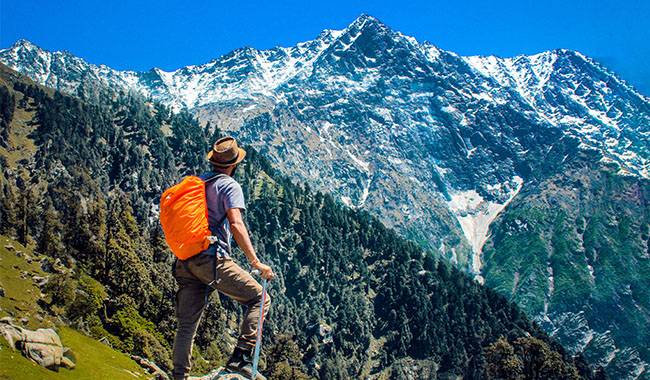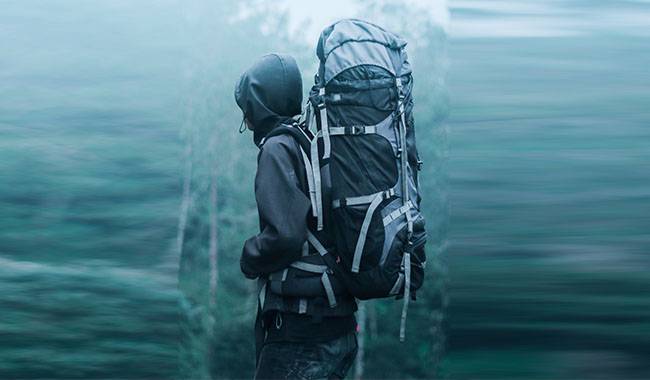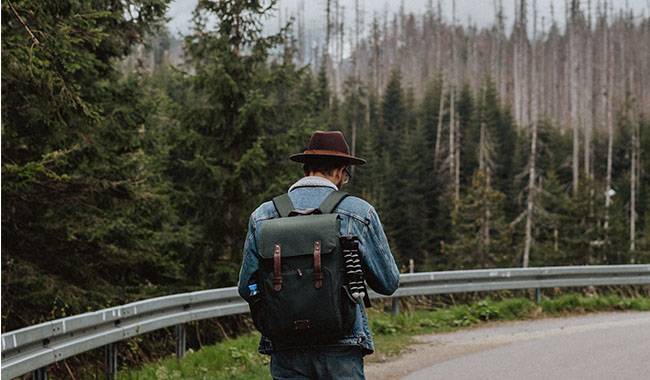
The lighter the weight of the pack on your back, the easier life on the trails will be. The pace is faster, the power is greater – and you can enjoy the scenery as you go. But, as many people joke, hiking is all about carrying heavy loads over long distances. There’s no getting away from the need to carry personal items, gear and food. You will learn more about The Weight of The Travel Backpack by LCNOutdoors article.
I’ll show you how much a backpack weighs on a mountain hike and how you can reduce it by planning your route wisely. I will share my experience on how to best distribute gear among participants and how to climb difficult passes with a heavy backpack.
How Much a Touring Backpack Weighs
The weight limit you can walk with a backpack without risking your health is very individual. It depends on physical fitness and mental stability. On average, it is 66 lb (30 kg) for men and 55 lb (25 kg) for women. In reality, people walk with heavier backpacks, for example, water tourists hiking down rivers with 88-110 lb (40-50 kg) on their backs. But these are usually one-off moments in the name of athletic performance that have nothing to do with recreation in the mountains. I am referring to the backpack, with which you can walk normally, overcome obstacles and enjoy the process.
Everything in a backpack can be divided into three categories.
- personal belongings and equipment.
- public equipment.
- fuel and products.
Personal equipment and food kits, as well as their weight, depend mainly on the season, the time of year and the length of the trek. The weight of special equipment depends on the difficulty of the obstacles on the route.
As an example, I will show you how much our packs weigh on a six-kilometer hike in the Fangshan Mountains. I use this as an example because the weight of the special individual and group equipment in the technical “six-pack” is the highest on a mountain hike. On this hike, one outfit can walk and sleep at elevations up to 3.4 miles (5.5 km).
Individual equipment
Total weight of personal gear (per person): 33 lb (15 kg) – (including everything you wear)
Of which, clothing worn: 10 lb (4.5 kg) – (boots, thermal underwear, fleece, rashers and pants, hat and gloves)
Special equipment: 10 lb (4.5 kg-) – (crampons, ice axe, helmet, ice drill, system, carabiner, etc.)
The proven weight of carrying personal equipment on your back is 25 lb (11.5 kg) – in a camping trip where no special equipment is needed, it will be 15 lb (7 kg).
Group gear (groups of 5)
Total weight of group equipment. 100 lb (45 kg) – (Our group equipment also includes sleeping bags – sleeping bags).
Of which special equipment: 45 lb (20.5 kg) – (ropes, rock hooks, etc.)
Electronic equipment (2 cameras, camcorders, GPS, solar cells, power packs, etc.): 13 lb (6 kg)
Weight per person: 20 lb (9 kg) -. 8 lb (3.6 kg) if you do not bring camera equipment and special gear.
Food and fuel (1 person)
Average weight of food layout: 580 grams per day.
Fuel: 70 grams per day.
Total 650 grams per day.
Tips: We used gasoline on the Fannin hike, but experience shows that gasoline and gas consumption are about the same. Don’t use these figures as a guide – the final figure depends more on the need for heated water, ambient temperature and availability of hot lunches. In summer camping without snow, gas consumption is about 50 grams per person per day.
Total weight of the backpack
The proven weight of a backpack with a full set of the largest special mountain equipment without food is: 45 lb (20.5 kg).
Weight without special equipment and large sets of electronic and photographic equipment: 23 lb (10.5 kg). It still has to add food and fuel to stay within the 66 lb (30 kg) limit. For technically demanding hikes, it is recommended to stay within 22 lb (10 kg). It has been shown that the maximum duration of the straight-line portion of such hikes (without resupply) should not exceed two weeks at most.
For hiking trails without special equipment, the straight-line portion can be up to 30 days in length. In fact, there are many examples of longer straight-line trips, but on such trips you have to start with a very heavy load, which is very stressful for the body.
Consider the different options for making your backpack lighter.
How to Unload Your Backpack on The Route

Reduce the weight of your backpack in any or all of these ways
- making reservations.
- picking up lighting equipment.
- facilitate product layout.
Do the scheduled work
To reduce the amount of food you carry, you can make some food on the route: you can drop off or pick up some food at predetermined locations where you will go out to replenish your supplies. In this way, the route is broken down into smaller parts – for example, if you do two trips in a month of hiking, you only need to carry food for 10 days instead of 30.
You need to plan your route and have a clear idea of how to organize it and how to pick it up afterwards. For example, the presence of circular sections or radial exits in the trail string will allow you to get through them relatively lightly.
You can leave a hill early, or you can leave on the way. In developed and popular areas, stores where you can buy food or fuel, alpine campsites and campgrounds can serve as overnight stays. In areas with a developed network of mountain shelters and huts, such as the Tatras, Alps and Pyrenees, you can plan to spend the night in “civilization” without having to bring a tent and a lot of food, thus making your pack lighter. In places where it is not possible to transport by car, a porter or pack animal service can be used to transport most of your belongings to the desired location.
You can put not only food, but also equipment and clothes, which are not needed at the beginning of the trail, but will be needed in the second part.
Choose lighting equipment
You can reduce the weight of your pack by choosing lighter equipment. Modern clothing and specialty equipment usually exceed previous models in weight, but also in performance and durability. But there are some things that were invented decades ago and are not widely used, but are still relevant today. For example, a lightweight titanium stove that can be used to cook with any kind of wood or garbage, saving a lot of fuel. Or a lightweight tent, i.e. a tent type multi-person tent.
When making your pack lighter, it’s important to choose the right equipment for the particular route and season. For example, it doesn’t make sense to use heavy steel trekking poles on steep ice if you only plan to hike on fir slopes.
In winter, people often use sleds, especially on ski trips. About a third of your total weight can be placed inside, relieving a lot of weight from your back. And if you are walking on flat or frozen water, you can carry your entire load on a sled. Depending on the terrain, the sled can carry part or all of the load
Easy product layout
Reduce your food allowance not by eating out – there’s no use starving yourself on the trail – but by cutting out the unnecessary. Eliminate unnecessary moisture by drying meats and vegetables. Eliminate unnecessary and heavy packaging. For example, don’t take canned food, which contains a lot of useless weight.
On long routes, we always use a differentiated spread. During the acclimatization phase, its weight is minimal (about 500 grams), because at the beginning of the route, the appetite of the participants is poor. Further along the route, the spread gradually increases, reaching 700 grams by the end. Such an approach allows not to discard food at the beginning and not to carry excess food, while at the end of the hike, when the appetite increases, no one will feel hungry.
How to Divide The Equipment In A Group
Distributing common equipment among campers seems like a simple problem. You divide it evenly among everyone, and then you’re good to go. But there are nuances here.
- In groups consisting of participants of different genders, girls are weighted less. The weight difference between men’s and women’s packs is usually about 6.6-11 lb (3-5 kg), depending on the length and difficulty of the route. It is best to adjust for this difference at the cost of public equipment. Giving girls less food is not really fair: at the end of the route, when there is almost no food, the weight of a man’s and woman’s backpacks is the same.
- The first thing to do is to distribute bulky items. Tents, group sleeping bags, canopies or pots and pans, stoves (for winter hiking) are distributed equally by the participants.
- When distributing equipment, the responsibilities of the participants in the group should be taken into account. For example, paramedics with first aid kits, refurbishers with repair kits, leaders with maps and navigators, photographers with cameras, etc.
- If the hiking route includes technically difficult obstacles, it is recommended that the group be divided into bundles, at least tentatively. The group should also distribute equipment for passing difficult sections: ropes, avalanche probes, shovels.
- Camping equipment is distributed according to the principle of “who uses it, who carries it”. It is not a good idea to let participants who do not sleep in their tents carry them.
- In the mountains, it is common to lose your equipment along with your backpack. Backpacks can fly off walls or fall into cracks, or float away while crossing rugged rivers. Therefore, important equipment, such as all burners or maps of the area, should not be owned by only one person.
- When assigning your equipment, it is worth considering its weight when wet – this is especially important for ski trips. Often, in rainy or frosty weather, there is no time or conditions to dry out the tent. It must be wet and heavier – it is advisable to take this into account beforehand.
- Expendable equipment, such as fuel or ring ropes, should be distributed equally among competitors, if possible.
- The speed and skill of the participants must be taken into account. For example, it does not make sense to give tents and cooking equipment to those who have been lagging behind. This should be given to those who are ahead of the pack so that tired runners will have camp and hot tea waiting for them at camp. It is better to give the ropes, hooks, and other “iron” to the technical leaders of the team. Then they won’t have to wait for teammates with the right equipment to start working the terrain.
- When assigning your equipment, you should consider your personal wishes and, if possible, give it to the owner to carry. It is more comfortable and relaxing to do so.
- In high-altitude mountaineering, a pass may take several days to complete. You must use a full set of climbing equipment to climb up and down the rock and ice walls. Unlike mountaineers who pack light, hikers have a heavy backpack on their backs.
How to Carry a Heavy Backpack to A Difficult Road

High-class mountain touring, where one pass can go for days. You have to climb and descend along the rock and ice walls using full climbing equipment. At the same time, unlike climbers who travel light, tourists carry a heavy backpack.
In this case, it is important to organize the climbing process correctly. Usually, the leader climbs first and arranges the belay, i.e. he belays on the difficult terrain climbed by the other participants. The choice of climbing speed and tactics is personal and depends on the skills of the participants, the nature of the terrain, and external conditions. I can give the following advice as a rough guide.
- on ice and easy rock steeper than 45-50°, the leader can climb with a pack.
- On steeper ice and moderately difficult rock up to 60°, the leader can climb with a lighter pack.
- On ice steeper than 60° and on difficult rocks, the leader can climb without a backpack.
In the latter case, the question arises: what to do with the leader’s backpack and how to get it upstairs? There are several options.
- The leader can partially or fully unload it by distributing his belongings among the other participants’ backpacks.
- The leader’s backpack will be lowered with it.
- Participants can pull out a backpack with a rope.
Rearranging your backpack or pulling it out with a rope is quite time-consuming and labor-intensive. That’s why this option is suitable for relatively short – no more than 492 feet (150 meters) – difficult pitches. If the group plans to climb along ice or rock wall, in most of which the leader can only climb without a pack, then one of the packs should be removed and things should be distributed among the participants.
Most weight issues on the route are best handled in the planning phase. This applies to all aspects: booking, choice of equipment, food distribution. And planning for the most difficult obstacles on the hike should be done at the end of the straight-line section before reaching the grocery store when the packs are as light as possible.
So, let’s summarize.
- The recommended weight of a backpack that can be safely hiked is no more than 66 lb (30 kg) for men and no more than 55 lb (25 kg) for women.
- You can reduce the weight of your backpack in a number of ways: choose lightweight equipment, reduce your food allowance, or make reservations.
- Allocate equipment within the group according to the gender, physical ability, and responsibilities of the participants.
- On difficult trails where you need to organize insurance, it is better to unload the leader and take his backpack apart.